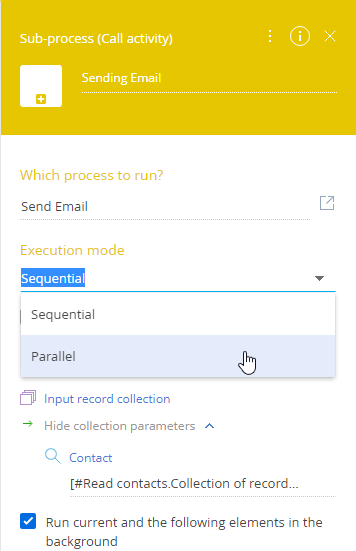Several types of process elements, namely the [Sub-process], [Read data], and [Call web-service], can have outgoing parameters of the “Collection” type. To be able to work with the collection “instances” (separate records within a collection), the collection needs to be processed.
There are several ways of processing a collection:
-
Pass a collection of records to another parameter of a “collection” type. For example, you can pass a collection of records to a [Call web-service] element that has a collection in its request parameters.
-
Use the [Script task] element to process the parameters of the “collection” type. For example, you can use a C# script to parse the collections of records into separate records that can be passed to other process elements.
-
Use the [Sub-process] element to handle each instance of a collection in a separate instance of the sub-process. If any of the incoming parameters of the [Sub-process] element are mapped to a data collection, the element will automatically run a separate instance of the sub-process per each instance of the collection.
Using sub-processes to handle “collection” parameters
Using sub-processes is the preferable method for working with collections, as it does not involve coding like the [Script task] element and is not limited by the capabilities of a third-party web service, like [Call web service].
The general procedure for processing a collection via the [Sub-process] element is as follows:
1.Prepare a process that will handle collection instances (this process will be used as s sub-process).
2.Add the [Sub-process] element in the parent process and select the prepared sub-process.
3.Map the incoming and bi-directional parameters of the [Sub-process] element to the parameters of the collection type.
Prepare the process that will handle collection instances
Create or modify a process that will work with a collection instance as if it were a single record. For example, to send an email to a collection of contacts, prepare a process to send email to a single contact (Fig. 1).
Fig. 1 Basic email sub-process

The incoming parameters of the sub-process must match the nested parameters of the collection. For example, sending an email requires the contact’s email address. This means that the collection must include the [Email] column, while the process for sending email must have corresponding incoming [Email] parameter, whose value is then passed to the [Send email] element.
Note
You can access subprocess diagram “on the go”, while working with the parent process, by clicking  (to create a new subprocess) or
(to create a new subprocess) or  (to edit the current subprocess) in the [Which process to run] field of the [Sub-process] element. Read more in the “[Sub-process] element parameters” article.
(to edit the current subprocess) in the [Which process to run] field of the [Sub-process] element. Read more in the “[Sub-process] element parameters” article.
Set up the [Sub-process] element
Add the [Subprocess] element on the diagram of the process where a collection parameter is obtained. Select a process that will handle collection instances in the [Which process to run?] field and map the incoming parameters of the selected process (Fig. 2):
Fig. 2 Mapping a data collection

Attention
Parameters of a [Sub-process] element can only be mapped to one collection. There are no restrictions on using values from non-collection parameters.
As a result, the [Sub-process] element will become a multi-instance sub-process. Multi-instance sub-processes initiate a separate process instance for each item in the data collection, using data from that item as parameter values.
Multi-instance sub-processes have two “execution modes” (Fig. 3):
Fig. 3 Selecting the execution method

-
Sequential. In this mode, sub-process instances run successively; each new sub-process instance runs upon completion of the previous instance. This is the default method.
-
Parallel. In this mode, the [Sub-process] element initiates all its instances at once, without waiting for the completion of the already running instances before running a new instance. Sub-process instances are unlikely to complete in the same order they started.
Upon completion of the last instance, the [Sub-process] element will update its outgoing and bidirectional parameter values from the corresponding parameters of the completed sub-process instances and activate its outgoing flows.
This means that after processing a collection, the [Sub-process] element can return a new collection, based on the incoming one. For example, in the case of sending emails to a collection of contacts, the sub-process can be configured to return a collection of sending results and/or errors.
When using the parallel execution methods, outgoing parameters are added to the resulting data collection as soon as the corresponding sub-process instance completes. As a result, the order of items in the resulting data collection is unpredictable. For example, a sub-process instance mapped to the first element in the incoming data collection may be the last one to complete.
See also






